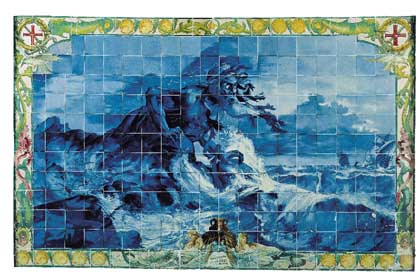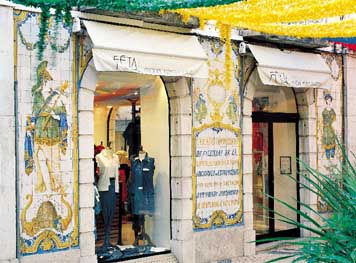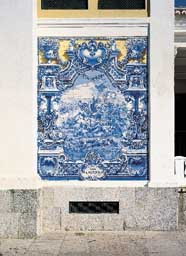|
|
|
|
|
|
|
|
|
|
|
|
|
|
|
|
 |
|
|
|
|
|
|
|
|
|
 |
|
|
|
|
|
The XIX · XX Centuries
Ecleticism
|
 ith its more austere façades, the architecture of the XIX century took on the function of a supporting medium for a variety of figurative scenes. ith its more austere façades, the architecture of the XIX century took on the function of a supporting medium for a variety of figurative scenes.
The practise of filling the walls of simple buildings containing property for rent with mass-produced repetitive motifs did not preclude the creation of individual signed compositions. Amongst their authors, Luís Ferreira (1807-?) deserves special note. Known as "Ferreira das Tabuletas", he produced exuberant panels depicting vases of flowers, trees and allegorical figures using the "trompe l'oeil" technique. His works, which he painted personally, were truly original and reflected the eclectic Romantic culture which marked Portuguese society in the second half of the XIX century.
Jorge Colaço (1868-1942) continued in this vein. He was originally an oil painter, but became known for the large-scale tile compositions he produced in Lisbon's Sacavém and Lusitânia Factories. His ceramic work prolonged the expression of what was an avowedly historicist taste - conceived in the late Romantic period with the intention of exalting characters and episodes of importance to the identity of the motherland - right into the XX century.
|
|
|
|
|
|
|
"Adamastor", Buçaco Palace Hotel,
Jorge Colaço, the Sacavém Factory, 1907.
photograph: Paulo Cintra and Laura Castro Caldas
|
|
|
|
|
|
|
|
|
|
 |
|
|
|
|
|
|
|
 |
|
|
|
|
|
|
Azulejo Façade, Casa Fétal,
Setúbal, Ferreira das Tabuletas, c. 1860.
photograph: Nicolas Lemonnier
|
|
|
|
|
|
|
|
|
|
 |
|
|
|
 |
|
|
|
|
|
|
|
Azulejo Façade, Campo de Santa Clara,
Lisbon, Ferreira das Tabuletas, c. 1860.
photograph: Nicolas Lemonnier
|
|
|
|
|
|
|
Azulejo Façade, Quinta de São Mateus,
Dafundo, Ferreira das Tabuletas, c. 1860.
photograph: Nicolas Lemonnier
|
|
|
|
|
|
|
|
|
|
"Ala dos Namorados",
Carlos Lopes Sports Pavilion,
Lisbon, Jorge Colaço, 1922 · 1927.
photograph: Paulo Cintra and Laura Castro Caldas
|
|
|
|
|
|
|
|
|
|
|
|
© Instituto Camões, 2000
|
|
|
|